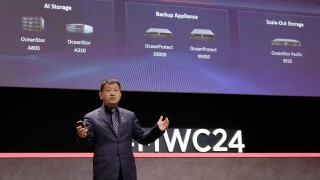|
Operating a cable on one of the largest possible segments of undersea paths in the world perhaps offers an altogether fuller insight into the challenges facing subsea cable systems.
As president and CEO of Southern Cross Cable Network since 2001, Fiona Beck has tackled the major task of developing Australia and New Zealand’s first major cable system that connects to the US via Hawaii, covering a staggering 28,500km and costing $1.4 billion.
Leveraging on that experience, Beck was also appointed president of the subsea telecoms trade body SubOptic in 2007, where she has continued to promote the best interests and practices of the industry.
Through both these roles, Beck has witnessed the strong growth and development of subsea cable systems worldwide, in what she now calls an “increasingly competitive market”.
Although subsea cable operators each face challenges specific to their particular region, many have the common goal of trying to find that competitive edge which can make them stand out on increasingly congested routes. Beck identifies several key changes within the industry which subsea cable operators must adapt to.
Firstly, the increase in availability of capacity on subsea systems has meant pricing models have changed, particularly on the more saturated routes: “Customers are now making sure they are getting the best possible pricing for capacity on cables and are able to shop around for those prices,” says Beck.
“Customers are looking at how operators are managing costs, particularly in areas like maintenance and operation, which they want as low as possible. They are also increasingly sensitive to backhaul and interconnection costs, and want flexibility through a range of service providers, either in the backhaul space or through PoPs. Certainly more systems now are leaning towards PoPs.”
Equally, a higher demand is being placed on operators to deliver a more reliable and resilient level of service. “It used to be that cables were something of a luxury item, whereas now they are very much a key infrastructure for any business and country,” Beck says.
“Governments are becoming far more conscious of key infrastructure and the role that cables play, and are therefore taking further measures to ensure they are protected through legislation. In turn, operators are under pressure to ensure their cables are more reliable in terms of performance and diversity.” By exploiting both these factors, subsea cable operators should be able to establish a strong reputation in the industry, which Beck believes is becoming even more paramount as longer commitments are made to customers.
Customers typically lease capacity on up to a five and sometimes 10 year basis, while IRUs can stretch up to 20 years. As a result, subsea cable operators are under bigger pressure than ever to prove their longevity. “These are long-term commitments and so customers really need to know the reliability and stability of the companies they are dealing with,” says Beck.
Upgrade versus new build
The global economic downturn curbed the rapid deployment of huge costly subsea cable projects, and caused operators to adopt a different, more calculated approach to planning and expanding routes. The boom in deployment of transatlantic cables over 10 years ago, which subsequently saw a dramatic drop in pricing that caused many cables to be sold off cheap and sent many businesses into receivership, proved a stark warning for the industry that still resonates strongly today. “While there are a lot of new systems entering the market, the one thing I am still seeing more of is upgrades. It is more of an upgrade market today than it is a new build,” says Beck.
The huge disparity in cost between a new build and upgrading an existing system immediately makes it more of an enticing option for operators. Beck estimates that the cost of an upgrade is between 10% and 20% the cost of creating a new build system: “If it costs you $400 million to build a new cable system or $40 million to upgrade an existing network, it’s usually a very easy choice,” she says.
Technology, however, is also playing a powerful role in the trend towards upgrades. “The technology suppliers have consistently delivered and there have also been a number of new suppliers in the market. They are enabling companies like Southern Cross to upgrade from 2.5G to 10G, from 10G to 40G and now we are even trialling 100G on our systems, which has been successful,” says Beck.
The success of the 100G trial is even more impressive given that it was conducted on an 8,000km segment of the Southern Cross system that runs from New Zealand to Hawaii. Upgrading extensive subsea links has proved a major challenge for technology suppliers in the past, particularly on transpacific routes. Beck believes, however, that new technology is proving it can rise to the challenge: “It’s a brilliant breakthrough, and as a consequence, a lot more companies like Southern Cross are focussing on the upgrade market rather than new builds.”
Developments down under
Such developments in the ability to upgrade cable systems are proving especially beneficial in Australasia, where demand for capacity has continued to soar. Due to the region’s sheer distance from the rest of the world as well as its generally low population density, many Australasian countries have traditionally suffered from much higher levels of pricing for capacity. Highlighting this fact, research from Southern Cross estimates that Australia can cost nine times more to service than other major transatlantic routes.
Subsea cable access to Australia has, however, increased substantially in recent years with Sydney now boasting access from Southern Cross, TGP Pacific Cable 1, Australia-Japan Cable and most recently Telstra’s Endeavour cable. “While Southern Cross was one of the pioneers in providing subsea cable access to Australia, there are now multiple systems and it’s more of a competitive market,” says Beck.
Capacity demand on the Southern Cross network out of both Australia and New Zealand has been growing at an annual rate of 35%. Growth over the last two to three years has been driven by rapidly increasing downloads per fixed-line subscriber, which are becoming more possible as average access speeds increase and international capacity prices reduce.
In the backdrop to this are the two country’s national broadband initiatives: Australia’s NBN and New Zealand’s UFB, which are designed to encourage the roll-out of fibre-to-the-home (FTTH) and increase the overall access speed of internet subscribers. “Certainly the policy aspects that are going on will increase growth too,” says Beck.
History lessons
The development of more cable systems into Australia also brings with it a greater level of route diversity, with the Australia-Japan Cable, for example, offering an alternative route via Guam.
This is a growing trend across the Asia-Pacific region in general, where operators are looking to counter the risk of natural disasters: “There has been a shift due to the disasters that have occurred, particularly in Japan and Taiwan where there has been seismic activity,” says Beck. “But marine engineers and cable route surveyors have generally been very good at identifying fault areas and trying to put cables on a path which is not so seismically active. You can’t, of course, always pinpoint where activity is going to occur and the industry is looking for more diversity. Carriers are also adopting more mesh networking, which is helping to improve redundancy and resiliency.”
All of this indicates that transpacific routes are showing signs of increasing maturity. Are they therefore in danger of experiencing the sharp fall in pricing experienced by transatlantic systems 10 years ago? “Prices are coming down similar to what happened on transatlantic routes, but I don’t expect to see such dramatic levels on trans-Pacific routes,” says Beck.
“A lesson has been learnt and in these economic times, it’s no longer a case of build and they will come. There have to be solid foundations and inherent customer demand before new cable systems are deployed. That’s why upgrades are becoming so much more attractive – the cost base is lower and you already have an established market to extend to.”
Key Facts: Southern Cross Cable Network
History: Construction of the Southern Cross cable system began in July 1999, and it became operational in November 2000. In April 2008, Southern Cross doubled the cable’s capacity to 860Gbps and then more recently upgraded it to 1.2Tbps in May 2010. Successful trials of 40G technology on the network have also led to plans to upgrade in Q2 2012.
President: Fiona Beck has served as president and CEO of Southern Cross since May 2001 and has previously held senior management roles at Telecom New Zealand.
Customers: Southern Cross sells capacity to telecoms providers, ISPs, private networks, global network providers and broadcasters.
Network: The Southern Cross Cable Network comprises over 28,500km of subsea and 1,600km of terrestrial fibre-optic cables in a triple ring configuration. The $1.4 billion system connects Australia and New Zealand to the US via Hawaii, with nine cable stations – two each in Australia, New Zealand, Hawaii and the US mainland, and one in Fiji – and an access point in San Jose, California.
Products and services: Southern Cross products utilise its ring-based network architecture to help provide capacity solutions to customers.








